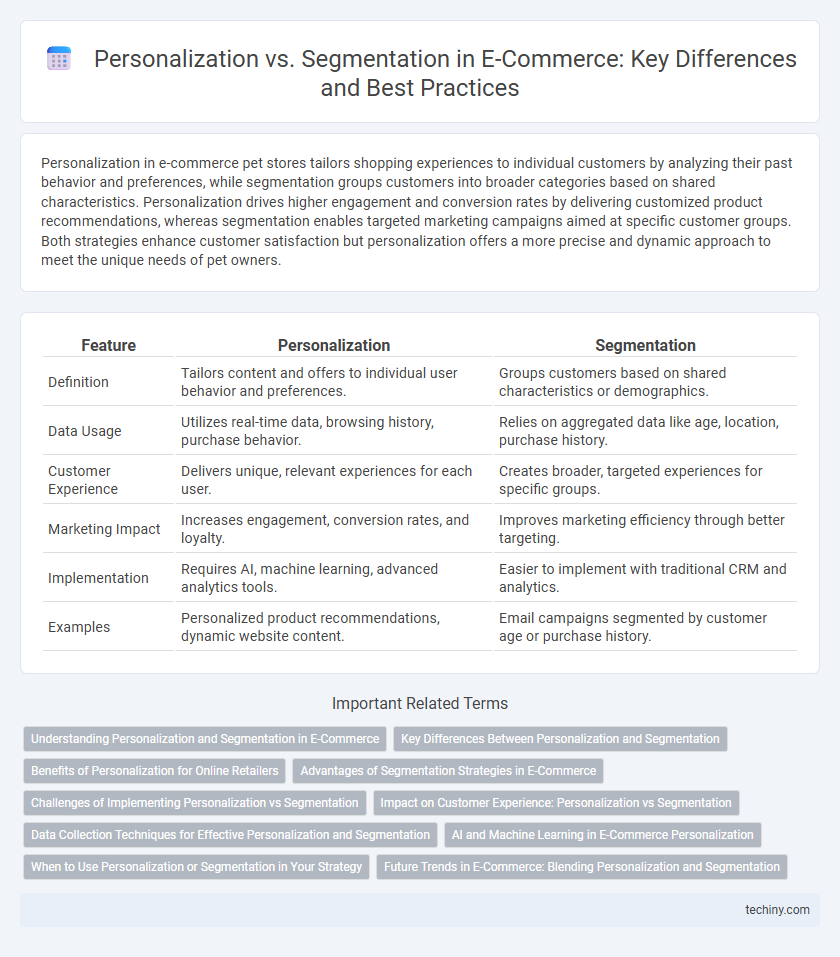Personalization in e-commerce pet stores tailors shopping experiences to individual customers by analyzing their past behavior and preferences, while segmentation groups customers into broader categories based on shared characteristics. Personalization drives higher engagement and conversion rates by delivering customized product recommendations, whereas segmentation enables targeted marketing campaigns aimed at specific customer groups. Both strategies enhance customer satisfaction but personalization offers a more precise and dynamic approach to meet the unique needs of pet owners.
Table of Comparison
| Feature | Personalization | Segmentation |
|---|---|---|
| Definition | Tailors content and offers to individual user behavior and preferences. | Groups customers based on shared characteristics or demographics. |
| Data Usage | Utilizes real-time data, browsing history, purchase behavior. | Relies on aggregated data like age, location, purchase history. |
| Customer Experience | Delivers unique, relevant experiences for each user. | Creates broader, targeted experiences for specific groups. |
| Marketing Impact | Increases engagement, conversion rates, and loyalty. | Improves marketing efficiency through better targeting. |
| Implementation | Requires AI, machine learning, advanced analytics tools. | Easier to implement with traditional CRM and analytics. |
| Examples | Personalized product recommendations, dynamic website content. | Email campaigns segmented by customer age or purchase history. |
Understanding Personalization and Segmentation in E-Commerce
Personalization in e-commerce tailors the shopping experience to individual customers using data like browsing history, purchase behavior, and preferences, enhancing engagement and conversion rates. Segmentation categorizes customers into distinct groups based on demographics, buying patterns, or location to target marketing efforts more effectively. Understanding these strategies helps businesses optimize user experience and drive sales by delivering relevant content and offers.
Key Differences Between Personalization and Segmentation
Personalization in e-commerce tailors individual customer experiences using real-time data, while segmentation groups customers based on shared characteristics or behaviors. Personalization delivers unique product recommendations and content, enhancing engagement and conversion rates, whereas segmentation targets broader audience clusters for marketing campaigns. Key differences lie in the granularity of data use and customization, with personalization operating at the individual level and segmentation at the group level.
Benefits of Personalization for Online Retailers
Personalization in e-commerce increases customer engagement by tailoring product recommendations and content to individual preferences, boosting conversion rates and average order value. It enhances customer loyalty through customized experiences, fostering repeat purchases and long-term retention. Utilizing AI-driven data analysis, personalization allows online retailers to dynamically adapt marketing strategies, resulting in higher ROI compared to traditional segmentation methods.
Advantages of Segmentation Strategies in E-Commerce
Segmentation strategies in e-commerce enable businesses to categorize customers based on demographics, behavior, and purchase history, leading to more targeted marketing campaigns. This approach increases conversion rates by delivering relevant product recommendations and personalized promotions to specific groups. Enhanced customer engagement and improved ROI are direct benefits of effectively implemented segmentation in digital retail environments.
Challenges of Implementing Personalization vs Segmentation
Implementing personalization in e-commerce often faces challenges such as data privacy concerns, the need for real-time data processing, and complex algorithm integration to deliver individualized experiences. Segmentation, while simpler, struggles with creating sufficiently granular groups that can effectively target diverse customer preferences without oversimplifying user behavior. Both approaches require robust data infrastructure and continuous optimization to balance relevance and scalability in marketing efforts.
Impact on Customer Experience: Personalization vs Segmentation
Personalization in e-commerce tailors product recommendations and content based on individual behaviors and preferences, significantly enhancing customer engagement and satisfaction. Segmentation groups customers by shared demographics or behaviors, enabling targeted marketing but offering less precise relevance than personalization. Personalized experiences drive higher conversion rates and loyalty by addressing unique customer needs, while segmentation improves efficiency in campaign management and resource allocation.
Data Collection Techniques for Effective Personalization and Segmentation
Data collection techniques such as web analytics, customer behavior tracking, and purchase history analysis enable precise segmentation of e-commerce audiences based on demographics, preferences, and buying patterns. Personalization strategies leverage real-time data from browsing behavior, clickstreams, and interaction history to deliver tailored product recommendations and customized experiences. Combining first-party data with AI-driven predictive analytics enhances both segmentation accuracy and personalized marketing effectiveness, driving higher engagement and conversion rates.
AI and Machine Learning in E-Commerce Personalization
AI-powered personalization leverages machine learning algorithms to analyze individual customer behavior, preferences, and purchase history, enabling tailored product recommendations and dynamic pricing. Segmentation groups customers based on shared characteristics but lacks the granularity and adaptability of AI-driven personalization, which continuously learns and evolves from real-time data. Advanced e-commerce platforms integrate deep learning models to deliver hyper-personalized experiences, increasing conversion rates, customer retention, and lifetime value.
When to Use Personalization or Segmentation in Your Strategy
Personalization enhances customer experience by delivering tailored content based on individual behavior, ideal for increasing conversion rates and fostering loyalty in high-engagement scenarios. Segmentation groups customers by shared characteristics such as demographics or purchase history, enabling targeted marketing efforts that are efficient for broad audience targeting and campaign scalability. Use personalization when data granularity and real-time interaction are available, while segmentation suits strategies requiring streamlined messaging and audience categorization.
Future Trends in E-Commerce: Blending Personalization and Segmentation
Future trends in e-commerce highlight the blending of personalization and segmentation to enhance customer experiences and increase conversion rates. Advanced AI algorithms analyze both individual behavior and group attributes, enabling dynamic product recommendations and targeted marketing campaigns. This convergence drives more efficient resource allocation and deeper customer engagement through hyper-relevant offers and content.
Personalization vs Segmentation Infographic

 techiny.com
techiny.com